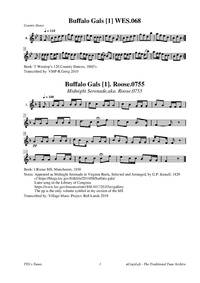Template:Pagina principale/Vetrina: Difference between revisions
No edit summary |
No edit summary |
||
| Line 1: | Line 1: | ||
{{SheetMusic | {{SheetMusic | ||
|f_track= | |f_track=Buffalo_Gals.mp3 | ||
|f_pdf= | |f_pdf=Buffalo Gals.pdf | ||
|f_artwork= | |f_artwork=DOWNTOWN_BUFFALO_LOOKING_NORTH_-_NARA_-_549477_(restored).tif | ||
|f_tune_name= | |f_tune_name=Buffalo Gals | ||
|f_track_title= | |f_track_title=Buffalo_Gals_(1) | ||
|f_section=X4 | |f_section=X4 | ||
|f_played_by=[https://soundcloud.com/ | |f_played_by=[https://soundcloud.com/thepinetreestringband The Pine Tree String Band] | ||
|f_notes= | |f_notes= Downtown Buffalo in 1973, showing the then-Marine Midland Tower, Niagara River and Buffalo's Lower West Side. | ||
|f_caption= | |f_caption=The name 'Buffalo' for the New York town derives from the name of a Native American. It was first called Buffalo Creek, becoming simply Buffalo as the town grew. It has been speculated, however, that the name of the tune/song derives from Erie Canal workers who frequented the prostitutes located on Goose Island, in Buffalo. | ||
|f_source=[https://soundcloud.com/ | |f_source=[https://soundcloud.com/thepinetreestringband/buffalo-gals Soundcloud] | ||
|f_pix=420 | |f_pix=420 | ||
|f_picpix=200 | |f_picpix=200 | ||
|f_article=[[ | |f_article=[[Buffalo_Gals_(1) | '''Buffalo Gals''']] | ||
This popular melody has been set in a variety of musical forms and genres. The name 'Buffalo' for the New York town derives from the name of a Native American. It was first called Buffalo Creek, becoming simply Buffalo as the town grew. | |||
It has been speculated, however, that the name of the tune/song derives from Erie Canal workers who frequented the prostitutes located on Goose Island, in Buffalo. The tune is widespread in American tradition, though as Samuel Bayard (1944) points out, the song is widely disseminated and is now an 'international melody'. | |||
Curiously, he thinks the air itself probably originated in Germany, but came to America and was assimilated in 'British style'. Instrumental versions, not surprisingly, are more ornate than vocal settings and display much wider variation, as a comparison of the sources listed below will attest. "Version B ('Johnstown Gals') affords a good example of how the influence of common melodic formulae, combined with tendencies toward attaining easy bowing and fingering will modify the outlines of a tune in instrumental tradition. | |||
Version A ('[[Hagantown Gals]]') is much like some recorded further south; B is in some ways distinctive...Sets from American tradition are Lomax, '''American Ballads and Folk Songs''', pp. 288–289; Ford, p. 53; Adam, No. 12; and three play-party versions from Texas in Owens, '''Swing and Turn''', pp. 45, 54, 103. (Bayard, 1944). See also "[[O Dear Mother My Toes are Sore (3)]]" for a 6/8 version ('A' part only). | |||
}} | }} | ||
Revision as of 11:45, 6 December 2023

Played by: The Pine Tree String Band
Source: Soundcloud
Image: Downtown Buffalo in 1973, showing the then-Marine Midland Tower, Niagara River and Buffalo's Lower West Side.

This popular melody has been set in a variety of musical forms and genres. The name 'Buffalo' for the New York town derives from the name of a Native American. It was first called Buffalo Creek, becoming simply Buffalo as the town grew.
It has been speculated, however, that the name of the tune/song derives from Erie Canal workers who frequented the prostitutes located on Goose Island, in Buffalo. The tune is widespread in American tradition, though as Samuel Bayard (1944) points out, the song is widely disseminated and is now an 'international melody'.
Curiously, he thinks the air itself probably originated in Germany, but came to America and was assimilated in 'British style'. Instrumental versions, not surprisingly, are more ornate than vocal settings and display much wider variation, as a comparison of the sources listed below will attest. "Version B ('Johnstown Gals') affords a good example of how the influence of common melodic formulae, combined with tendencies toward attaining easy bowing and fingering will modify the outlines of a tune in instrumental tradition.
Version A ('Hagantown Gals') is much like some recorded further south; B is in some ways distinctive...Sets from American tradition are Lomax, American Ballads and Folk Songs, pp. 288–289; Ford, p. 53; Adam, No. 12; and three play-party versions from Texas in Owens, Swing and Turn, pp. 45, 54, 103. (Bayard, 1944). See also "O Dear Mother My Toes are Sore (3)" for a 6/8 version ('A' part only).
...more at: Buffalo Gals - full Score(s) and Annotations
X:4 T:Buffalo Gals [1] M:2/4 L:1/8 S:Shaw - Cowboy Dances (1943) Z:AK/Fiddler's Companion K:F V:1 clef=treble name="4." [V:1] z2 zC|FG AB|dc A2|cB G2|dc A3C| FG AB|dc A>f|ec BG|F3z|| f/f/e dc/c/|d/cB/ A2|c/BA/ G2|d/cB/ A2| f/f/e dc/c/ d/cB/ A>f|ec/c/ BG/G/|F3 z||
